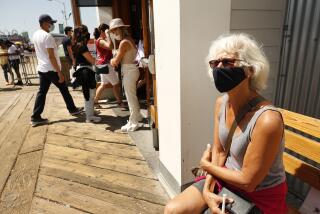O.C. Heart, Stroke Deaths Near Average, Study Shows
- Share via
The first-ever city-by-city breakdown of deaths from heart disease and stroke in California shows that most cities in Orange County have a mortality rate at or below the state average, although several communities have above average death rates.
Residents in Dana Point had the lowest heart disease mortality rate in the county by a wide margin, followed by San Clemente and Irvine.
The researchers, from UC San Francisco and the California Department of Health Services, pointed out that, aside from the risks posed by air pollution, it is not simply physical presence in the cities that defines heart attack risk. Instead, a person’s address is a tip-off of possibly shared social, economic and cultural factors that increase risk. Those factors include access to health care, diet, smoking and poverty.
Cities with higher death rates also tended to have larger populations of low-income people and recent immigrants, who often are unable or reluctant to see a doctor for anything but serious illnesses.
“They’re not utilizing the medical care facilities from a standpoint of prevention, screening and early detection as perhaps individuals of a higher socio-economic status would, say, in South Orange County,” said Nathan Wong, director of the preventive cardiology program at UC Irvine.
“Especially Hispanic populations tend to be more hesitant to seek health care until it has become a very critical issue,” Wong said.
Poorer cities also tend to have a higher number of uninsured or underinsured people who are less likely to seek preventive health care.
Although deaths from cardiovascular diseases in California have declined almost 50% since 1972, an estimated 87,000 people die from them each year. Cardiovascular disease--which includes heart disease and stroke--accounts for about 42% of all deaths in the state, making it the leading killer.
Maywood, Montclair, Riverside and Whittier in the Los Angeles area and Citrus Heights in Sacramento County have the highest death rates from heart disease.
Statewide, the cities with the highest death rates from stroke were Danville, Redwood City, Santa Barbara, Whittier and Yucaipa. A person living in Yucaipa is three times as likely to die from stroke as a resident of Monterey Park, the city with the lowest rate. No city in Orange County had a mortality rate from stroke that was significantly higher or lower than the state average.
The study “gives us the opportunity to identify high-risk areas and to let leaders in those areas know there is a problem,” said Jeannie M. Gazzaniga, co-author of the report. “And there are solutions. Heart disease and stroke are largely preventable.”
“The study is important because, with limited resources, we want to target prevention in areas where there is the highest rate of death,” said George Kaplan, chief of the state’s Human Population Laboratory in Berkeley. “It shows that there are a substantial number of cities, 15% or so of the total, which have elevated death rates from heart disease. I don’t think we could have predicted which cities those would be.”
“One of the things this report tells me is that we need to be addressing some of the chronic diseases,” said Dr. James Haughton, medical director of public health for Los Angeles County. “To date, the emphasis has been on control of acute communicable diseases.”
Wong agreed that the funds from the state Department of Health Services to community clinics, often targeted to fight infectious diseases, or to treat drug abuse and provide prenatal care, also need to be provided for heart disease prevention.
“They’re certainly important, but what happened is there’s inadequate funding and there lacks an organized cardiovascular disease prevention program at the local level,” Wong said.
The most surprising aspect of the report, he added, was that in six of the cities in Los Angeles County, women had a higher death rate from heart disease than men, which bucks the trend elsewhere in the state and nation. “It does seem we need to give more attention to the heart problems of women,” he said.
The study was conducted by the health department’s cardiovascular disease outreach, resources and epidemiology program, which was created in 1992 to focus resources for combating heart disease. Gazzaniga is the CORE program’s director.
The study looked at each of the 245 California cities with a population of 20,000 or more in 1990 and examined deaths over the three-year period 1989-91. Causes of death in each city were obtained from state statistical records and an absolute rate, adjusted for age and race, was calculated for each city.
That rate was then compared to the rate for the state as a whole.
Citrus Heights had an annual heart disease rate of 283.94 deaths per 100,000 people, while the state as a whole had 158.99 deaths per 100,000. The relative rate in the city thus was 1.78, highest in the state.
For strokes, Yucaipa had a rate of 90.87 deaths per 100,000 people annually, compared to the statewide average of 52.78 per 100,000, giving a relative rate of 1.72. Stroke and heart disease rates were generally higher among men.
Many of the cities with the highest rates were in San Bernardino County. The high incidence in the county “is not new information to us,” said Dr. Tom Prendergast, the county’s director of public health. The county had been shown to have the highest death rate from heart disease in the state, but the new study is the first to point to specific problem areas. One reason for the high risk, he noted, is that the county has the highest rate of smoking in the state.
The health department there has had a number of campaigns to attempt to change people’s behavior, he noted, “but hopefully this [report] will stimulate both us and the communities to take a look at what else can be done.”
The study says nothing about how a city might contribute to cardiovascular disease. But it is well known from prior studies that unhealthy habits, poverty, air pollution and lack of medical insurance all are important contributors, Gazzaniga said. “We just don’t know the extent to which each factor is important,” she said.
CORE has therefore launched an intensive 18-month study of two adjacent cities, Fontana and Rancho Cucamonga, to try to tease apart the relative importance of each factor. Fontana has a high risk while Rancho Cucamonga has a low risk.
“We’re just getting our toes wet in a problem with enormous proportions,” Kaplan said.
Meanwhile, Mary Anne Morgan of the Contra Costa County Health Services Department said the results cry out for local investigation of the reasons for elevated rates in the worst cities and implementation of corrective measures. “We do have a prescription for what works in preventing [cardiovascular disease],” she said.
Much can be done to improve the situation, experts agreed. Some approaches that have been successful include expanding farmers markets to make more fresh fruits and vegetables available, promoting biking and walking, investing in economic development in poverty areas, and reducing air pollution.
Contributing to this report was Times staff writer Lisa Richardson.
(BEGIN TEXT OF INFOBOX / INFOGRAPHIC)
Death Rate Data
Here’s how mortality rates for heart disease and stroke in Orange County cities compare with each other and the statewide rates. Data is for 1989-91, per 100,000 people. It is also race and age adjusted. The relative rate is the ratio of each city to the statewide number
*--*
HeartDisease Stroke Mortality Relative Mortality Relative City/community rate rate rate rate California 158.99 1.00 52.78 1.00 Anaheim 216.91 1.36 56.39 1.07 Buena Park 200.15 1.26 55.69 1.06 Costa Mesa 166.54 1.05 51.97 0.98 Cypress 160.28 1.01 46.65 0.88 Dana Point 71.40 0.45 N/A N/A El Toro 162.74 1.02 52.50 0.99 Fountain Valley 162.68 1.02 61.75 1.17 Fullerton 191.96 1.21 56.95 1.08 Garden Grove 194.02 1.22 53.25 1.01 Huntington Beach 160.03 1.01 50.89 0.96 Irvine 130.88 0.82 41.29 0.78 Laguna Beach 135.91 0.85 41.79 0.79 Laguna Hills 151.10 0.95 43.81 0.83 La Habra 212.23 1.33 53.83 1.02 Mission Viejo 136.85 0.86 56.22 1.07 Newport Beach 158.92 1.00 55.53 1.05 Orange 178.06 1.12 46.75 0.89 Placentia 152.35 0.96 78.59 1.49 San Clemente 129.68 0.82 59.85 1.13 San Juan Capistrano 136.93 0.86 59.68 1.13 Santa Ana 189.71 1.19 49.01 0.93 Seal Beach 165.96 1.04 42.99 0.81 Stanton 173.05 1.09 60.11 1.14 Tustin 191.08 1.20 45.44 0.86 Westminster 165.87 1.04 48.72 0.92 Yorba Linda 197.96 1.25 56.45 1.07
*--*
Note: Information for some cities unavailable
N/A: Insufficient data to calculate rate
Sources: California Department of Health Services, UC San Francisco, Los Angeles Times
More to Read
Sign up for Essential California
The most important California stories and recommendations in your inbox every morning.
You may occasionally receive promotional content from the Los Angeles Times.













